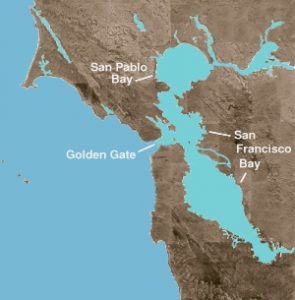
San Francisco Bay has had a dynamic and complex history over the past million years as sea level rose and fell at least four times with alternating warming periods and glaciations. About 13,000 years ago, the first group of humans arriving in the area would have walked through a valley with a river flowing nearly 48 km out toward the ocean. The current bay formed only about 6,000 years ago.
In a recent paper published by Quaternary Research, Amy Lesen, former PhD student in UCMP and currently Chair of Biology at Dillard University in New Orleans, and Professor of the Graduate School Jere Lipps, compare the foraminifera present in the San Francisco Bay today with what was present 125,000 years ago. According to their results, not much has changed in the species that are present. However, the human introduction of a Japanese invasive species, Trochamminia hadai, in 1983 dominated the native foram species and produced more change in the microfaunal assemblage within the last 30 years than within the time it has taken to form the bay. This work sponsored by the UCMP serves as an example of how human actions can have a more severe impact within a small amount of time than the natural changes that take over several millennia.
